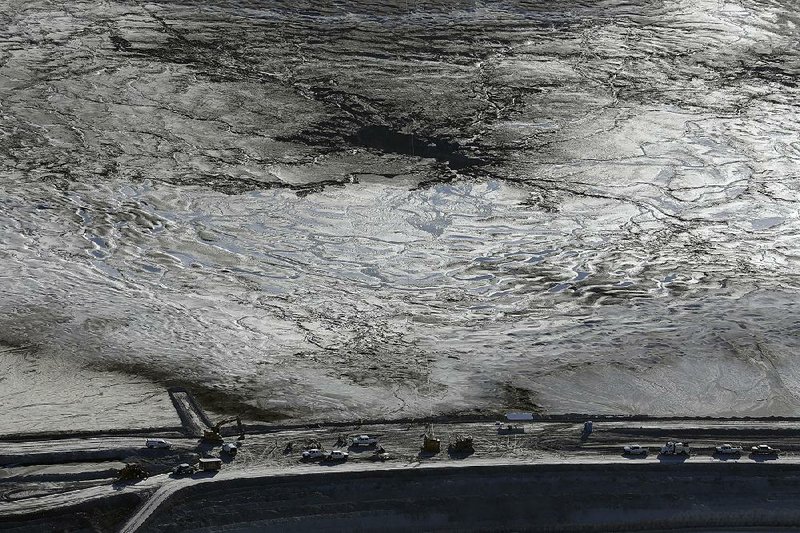MULBERRY, Fla. -- People living near a sinkhole that's sending contaminated water and fertilizer-plant waste into Florida's main drinking-water aquifer are fearful, and fuming that it took three weeks for them to be notified about the problem.
Many are waiting anxiously for the results of tests for radiation and toxic chemicals in their water wells.
So far, more than 200 million gallons of tainted water from a waste heap at the plant have drained into the 45-foot-wide sinkhole. The tainted water has flowed into the Floridan aquifer, which provides water to millions of people.
The Mosaic Co. -- one of the world's largest producers of phosphate and potash for fertilizer -- acknowledged Wednesday that the contamination has spread to groundwater around the sinkhole.
On Thursday, company spokesman Jackie Barron said acidity and sulphates were found in a recovery well that's being used to pull water out, within a quarter mile of the sinkhole.
On Wednesday, she said traces had shown up in several wells on the plant site. On Thursday, however, she said contamination was found only at the recovery well, and that no contamination has been found in the monitoring wells farther from the sinkhole, nor beyond the limits of the company's property.
On Aug. 27, a Mosaic Co. employee discovered that wastewater under the heap had flowed out through the sinkhole, and the state and U.S. Environmental Protection Agency was notified the next day, as required by Florida law, said David Jellerson, the company's senior director for environmental and phosphate projects.
However, homeowners near the Mosaic Co.'s New Wales plant weren't notified of the problem until Sept. 19, after news of the sinkhole broke the previous week. That's when Mosaic Co. began providing people with bottled water.
By then, the wastewater pond had mostly disappeared through the sinkhole under a pile of phosphogypsum, a fertilizer byproduct that contains minute traces of radiation.
Mosaic Co. stacks the phosphogypsum in piles that can be hundreds of feet high and visible even from space.
Because it is radioactive, the material can't be reused, and the resulting wastewater is stored in ponds.
Aerial photos and video taken Thursday show that wastewater is still flowing into the aquifer, which stretches beneath Florida and southern Mississippi, Alabama, Georgia and South Carolina.
Mosaic Co. also acknowledged that it doesn't know how deep the hole has grown. Barron said the company believes it's 300 feet deep, but doesn't yet know for sure.
Also, it's still hurricane season in Florida. Barron said "any storm is going to add water to the mix, and that water will continue to flow though that sinkhole until we plug it."
And plugging it won't be easy.
The hole is deep within the massive "gypsum stack," a gooey pile of claylike material, said Sandy Nettles, a Florida geologist who is a sinkhole expert.
"Compared to a regular sinkhole, it's a lot more effort and money and equipment to deal with it, but it can be done," said Nettles. "Clay slime can't be put in the ground, anything put on top will sink. It's like trying to work on quicksand."
Meantime, the company is advising people not to drink their well water, said Courtney Tinsley, 38, who lives in the rural community of Lithia, less than 2 miles from the plant.
"I said 'If we can't drink it, we shouldn't be bathing in it too,'" she said. "I have a 4- and 13-year-old, and I do have a concern every time I give them a bath."
Florida Department of Environmental Protection spokesman Dee Ann Miller on Thursday did not address why the agency took so long to notify the public, but said the safety of Floridians and the environment are a top priority. The agency so far has not released public records on the water testing data.
The delay led Florida Gov. Rick Scott, who toured the site Tuesday, to enact an emergency rule requiring 24-hour notice of environmental emergencies, and he plans to support legislation to make that permanent in next year's legislative session.
Mosaic Co. said some partial results were released to some residents Tuesday, and the labs are working as fast as they can. Mosaic Co. hired a private contractor for its testing. The Florida Department of Environmental Protection, meanwhile, is separately taking and testing samples from private wells.
Mosaic Co. understands that neighbors want peace of mind, Barron said. The company is drilling more monitoring wells to better be able to find any migration of the wastewater.
"We appreciate how people feel at this point -- that's why testing and bottled water continues," Barron said.
But criticism has been mounting over how long it took to notify the public about potentially radioactive material in the water supply.
"The EPA, the DEP, Gov. Rick Scott, where are they?" asked Paula Largel, a nursing-home worker who lives about 14 miles from the sinkhole, in the nearby town of Mulberry.
"It makes you wonder how long Mosaic would have sat on it if the news crews hadn't broken the story," said Largel.
Tinsley said she first heard about the problem on the evening news, and called the Mosaic Co. for more information. She was able to reach only a guard, she said, and couldn't talk to a company official for days.
Tinsley and other residents have filed a federal lawsuit seeking damages for possible losses of their private wells and the costs of testing, monitoring and treatment of their wells.
A Section on 09/30/2016
